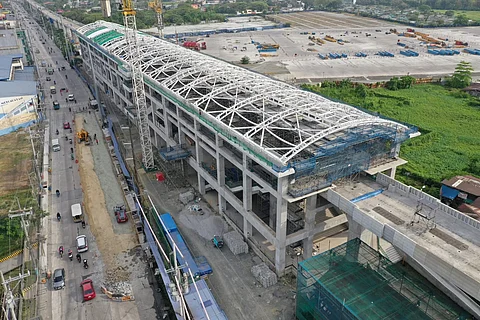
- NEWS
- the EDIT
- COMMENTARY
- BUSINESS
- LIFE
- SHOW
- ACTION
- GLOBAL GOALS
- SNAPS
- DYARYO TIRADA
- MORE

In Asia, where geopolitical dominance usually involves men in suits standing on aircraft carriers, Japan has chosen a different approach. It builds things. Useful things. Sometimes very boring things. Drainage canals. Trains. Flood sensors. Not sexy, but effective.
This is how Japan whispers in a region full of shouting. And then it quietly hands you a bridge, and tells you where to sign.
The Philippines has been one of the luckier recipients. While Beijing stakes territorial claims by erecting artificial islands, and Washington sends aircraft carriers named after presidents, Japan sends tunnel-boring machines and engineers.
You get the sense that Japan would rather you forget it was ever in the war. Instead, it wants to be remembered for that one train that ran on time.
A TUNNEL TOO FAR
The Metro Manila Subway is the kind of project that inspires press releases before it inspires tunnels. It’s been “halfway done” for what feels like a decade, though actual drilling has only happened in one or two places, and, even then, very shyly.
Officially, this subway will carry 400,000 passengers daily and reduce a bone-grinding 90-minute commute into a brisk 40-minute ride.
Unofficially, it is a complex and expensive dare to Manila’s geology and bureaucracy. Japan has loaned more than ¥400 billion to get it moving. The Japanese expect things to start and end on time. The Philippines often treats deadlines like quaint suggestions.
Completion is now projected for 2032. Originally, it was 2024. Then 2026. Then 2028. By 2040, this thing may go from hypothetical to historical.
And yet, even unfinished, it’s changing the rules. Japanese engineers are holding Filipino contractors to international standards. Stations are being designed with things like airflow in mind.
THE GHOST TRAIN
Now consider the North–South Commuter Railway. It exists, technically.
As concrete. As rumor. As a half-formed thought stretching between Clark and Calamba.
More than half of it is reportedly built. It has no passengers. It has never moved. It both exists and doesn’t.
The plan, originally ambitious, was to cut travel time in half and move nearly a million people a day by 2027. Then 2028. Then a soft murmur and an apologetic shrug. Digging is hard. Permits are harder. And the laws of physics, it turns out, are more forgiving than the Department of Public Works and Highways.
But the thing is being built right. Seismic resilience, flood defenses, modern signals: each part bears the fingerprints of Japanese advisors.
SUCCESS IN SPACE
In 2016, the Philippines slipped a satellite into orbit. It did not self-destruct, veer off course, or become an expensive piece of space junk, outcomes many quietly expected.
This was Diwata-1. Then came Diwata-2. And Maya-1. Each built in collaboration with Japanese universities. Each one proved a simple formula: take a batch of sharp Filipino scientists, send them to Japan, pair them with engineers who lose sleep over screw torque and, eventually, something launches that doesn’t explode.
Now those satellites hang up there, quietly doing the kind of work that matters. They sniff out storms before they hit. They tip off farmers when crops are about to drown. They beam back images that turn chaos into preparation, guesswork into survival.
SHIPS WITH DIFFERENT ORDERS
Off Palawan, two Japanese-funded vessels wait: The BRP Teresa Magbanua and BRP Melchora Aquino. They’re named for women. Their mission is mercy.
They are technically for law enforcement. Realistically, they are used for rescues, weather tracking, ensuring that when someone radios for help, the response is more than static.
These ships arrived via a ¥16-billion ODA package from Tokyo, which tends to give away capital equipment, quietly, without much ceremony, and in surprisingly good condition.
They have participated in joint exercises with Japan and the US, but mostly they stay close to home. They respond to typhoons. They help stranded boats. They enforce laws in a region where laws are usually suggested by megaphone.
Their presence is persistent. And it tells a different story: You don’t have to be loud to be powerful.
So here’s what Japan is doing in the Philippines: It is building stuff. Just to work. And once something works, really works, it’s hard to un-build. Hard to argue with. Hard to ignore.
